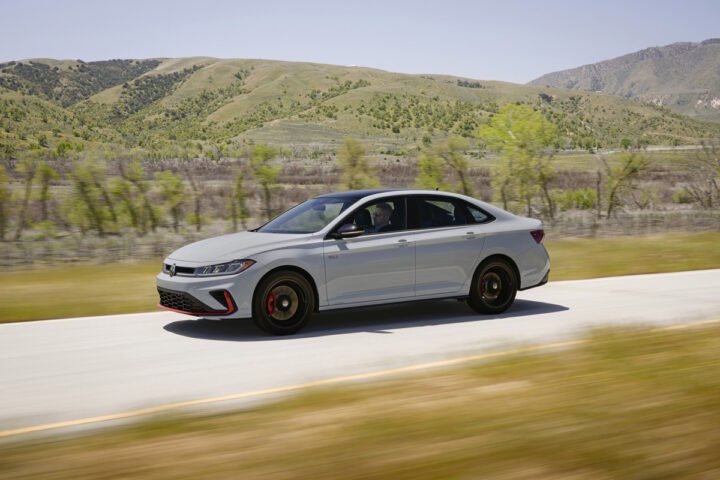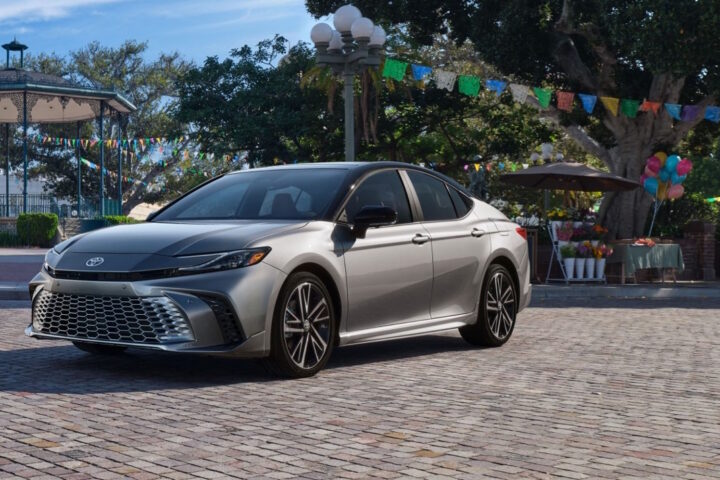by Anthony Fongaro
Styling is very important for a vehicle. Sometimes, you want to show that your truck or SUV looks tough, even if they’ll never go off-road. Other times, luxury touches can be added to ordinary vehicles to help with the upscale appeal. Finally, there are performance-oriented styling. These can include aerodynamic upgrades, bigger wheels, and performance seats. Although some of these performance upgrades can be used on a track, most of the time, the car will never go onto the track. That’s particularly true with my test-car. It showcased that visual performance upgrades don’t exactly help.
What I had was a 2020 Toyota Camry TRD. Normally, the Camry can look a bit sporty in SE trim or more run-of-the-mill in other trim levels. You can also get a hybrid Camry that gets impressive gas mileage. For some reason, Toyota decided that there needed to be an entry into the world of the Camry’s V6 and tries to justify the styling of the Camry TRD. Pushing stying aside, I understand why Toyota did this. Camry’s are looked at to be mundane family sedans and they wanted to make it look exciting. It’s the entry to Toyota’s 3.5-liter V6 producing 301-horsepower and 276 lb-ft. That said, when my week was up with the Camry TRD, it certainly left an interesting opinion on me.
It may be a more polarizing Camry, but that doesn’t mean it strays too far from a regular Camry. This means that despite some of the styling upgrades for the TRD I’ll explain later, the normal design of the Camry is sedate. It won’t win any beauty pageants, but the usual design has some great looking headlights and taillights. There are some models that can two-tone paint that I really appreciate. For the TRD, you actually don’t get full LED headlights. They’re Bi-LED with auto on/off feature. The rear lights also aren’t full LED since they’re a combination LED light. This is where the cost-cutting begins.
Moving into the interior, the cabin looks similar to a regular Camry. There is a 4.2” TFT screen in the middle of the red dials for a digital speedometer and other information such as fuel economy. The sportier Camry’s get a leather steering wheel with controls for the infotainment system, adaptive cruise control, voice-commands, and lane departure alert. You’ll see the 7.0” infotainment system with physical buttons for navigation, audio, and apps. Apple CarPlay, Android Auto, and Amazon Alexa are included. Safety-wise, Toyota is nice to equip all Camry’s with their Toyota Safety Sense with pre-collision and pedestrian detection, lane detection, automatic high beams, and adaptive cruise control.
Regular information over, it’s time to move onto the specifics of the TRD trim level. The exterior can only be described as way-too over the top or the correct amount of sporty. There are styling upgrades including black outside mirrors and window trim, big 19” TRD matte-black wheels, and many TRD badges. My test car had a red and black paint job which, along with the wheels, did give the Camry TRD lots of presence. If you are looking for presence and a polarizing look, check out the rear. There is one thing that I like: the TRD dual exhaust, mostly because they make the Camry sound great.
Unfortunately, Toyota decided to give the Camry TRD a spoiler, and that’s where things go wrong. Remember, this is a front-wheel-drive family car, and the spoiler ruins the look. It really makes the Camry TRD look more aftermarket and almost boy-racer. Changes to the inside include a lot of TRD floormats, a TRD shifter, and TRD specific seats. I actually do like interior much more than the exterior. Aluminum pedals and a metallic trim actually gives the illusion of increased performance. Although the TRD has the same ECO, Normal, and Sport mode, ECO almost felt silly to use.
For Toyota, this is the entrance to the world of the V6. I wish that, for a performance-oriented sedan, there was an increase in power. It drives well, but it certainly isn’t a sports sedan. The best part of the driving experience is the upgraded exhaust system. Since the V6 is naturally aspirated, it does sound quite good. TRD helped with the handling and included some modifications to the suspension. I’ve never driven a normal Camry, but the TRD did feel good in the corners. Out of all three modes, I was in normal the most. Sport mode was fun on the highway but completely useless and kept the revs in the eight-speed automatic too high.
When I first got into the Camry TRD, I noticed something right away: there weren’t any blind-spot monitoring systems. That surprised me but was just the beginning of the lack of features. If you go for the TRD, there are some sacrifices that you’re going to make. First, the infotainment system and instrument display are the stock sizes. You also can’t get navigation on the TRD but that’s fine since you can use your phone. That said, using Apple CarPlay was quite difficult to use. I had to download Toyota’s Entune app just to use it and it constantly disconnected.
Next, the lack of a sunroof. I’m not the biggest fan of a sunroof but it would have been nice to have. This is understandable if you’re trying to have the look and feel of a performance car. Funny enough, the TRD weighs the same as most other Camrys. The seats aren’t heated nor is the steering wheel and the rear seats don’t fold down due to a strut-beam in the trunk. This was the only car I’d ever tasted that didn’t have fold-down rear seats which is different.
What does this all mean in terms of the Camry TRD? Is it a good family car, a fake performance sedan, or a trim level that should be skipped? I have a few opinions and wishes on that. Having the TRD be the entry to the V6 is nice and the added performance it gives is nice. Camry’s have another trim level called the XSE V6, and that’s the trim I would get. Yes, the TRD starts at $31,000 while the XSE is $35,000. Normally, I try to parse down options but in this instance, the added features of the XSE make sense.
My wishes for the TRD can be seen as a little out-there, but they’re all justified. Just give it the option to have the features the XSE has! I’ll gladly pay more for blind-spot monitoring. The spoiler is the point of contention and I had many people try to race me on the road. I don’t do this regardless, but I had a lot of V8s rev at me. To rectify this, make the spoiler an option and maybe use a smaller trunk-spoiler. Finally, the TRD should be the top-trim. This means it needs more power and all-wheel drive. A twin-turbo V6 would certainly pair well with the styling. Would this drive the TRD to around $40,000+? Yes. Would it be worth it? Absolutely.
The Toyota Camry TRD really isn’t a bad car. While it’s interesting that Toyota decided to omit many features, I did enjoy driving it. The V6 with the upgraded exhaust made it feel fun. If you’re looking for a sedan that’s out there but is less than $35,000, the Camry TRD is almost the only car you can find. For anyone else, the added cost of the XSE V6 has everything you need. Either way, it’s a Camry so you get good build quality and a competitive interior.
























